
Kirsten McCarthy / Cats.com
Cats are usually excellent at grooming themselves. They spend a large proportion of their day cleaning themselves and enjoy it. Sometimes, however, cats need a little help from their humans. This is especially true if a cat gets poop on their fur around their back end as this is a particularly hard-to-reach place for them. You might catch your cat scooting, too, which can indicate a problem with their anal glands.
Cats are very good at cleaning themselves, but sometimes they get poop on their coat and they struggle to remove it without help. It is our job to help them clean the cat poop out of their coat when this happens. There are many ways to go about this. If you follow the advice in this article, you will be able to safely and effectively clean your cat's fur without causing you or them undue stress.Key Takeaways
Some cats struggle to clean themselves properly. For example, older cats with arthritis aren’t as supple and flexible as they once were. Cats recovering from surgery might not be able to move around to reach certain places. Cats that have sustained an injury might have a reduced range of motion. Overweight cats can also struggle. This is where people come in!
1. Preparation Is the Key
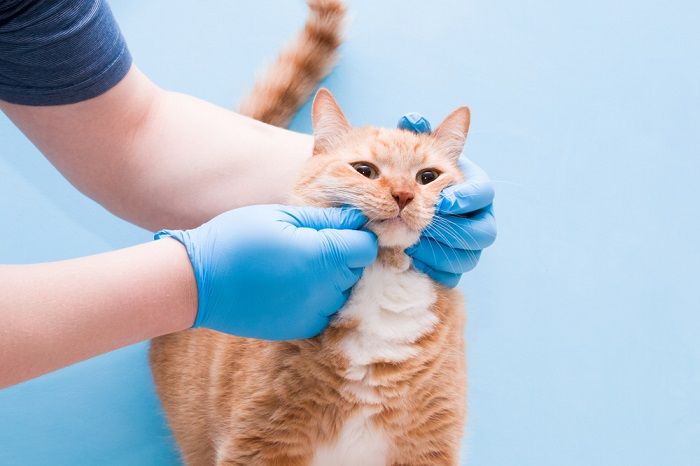
When cleaning up cat feces, it’s best to wear gloves and even eye protection if it’s a large mess.
Once you have established that there is a poop-cleaning job for you to undertake, there are a few things you need to do to protect yourself. After all, this is cat feces, which can harbor bacteria and parasites.
First, it’s important to cover your arms and hands. You can either use long rubber gloves or short gloves and a long sleeve top. This is partly to keep your hands clean and partly because your cat might not like being washed and might try to scratch you.
Cat scratches are painful and can get infected, so it’s best to avoid them. You might want to pop an apron over your clothes to stop splashes and poop particles from getting on them.
If you have some, wear a pair of goggles or safety specs over your eyes. Your eyes need protection from splashes of poop-infested water. If you get an infection in your eye from the contaminated water, it will not be pleasant.
Also Read: The 7 Best Calming Cat Treats
2. Poop Cleaning Tools

Before getting started, organize everything you might need so it’s within arm’s reach.
Gather all the tools you need before you start cleaning your cat. Trying to grab something you forgot with a wet, soggy, stressed-out cat that, is not be easy. Preparation is the key. Below is a list of all the useful things you might need:
- Apron
- Goggles
- Rubber gloves
- Cat shampoo
- Waterless cat shampoo
- Pet wipes
- Towels
- Brush
- Comb
- Scissors or pet clippers
- Pet dryer
- Disinfecting spray or wipes
Also Read: How To Clean A Cat’s Butt In 6 Simple Steps
3. Techniques for Removing the Poop
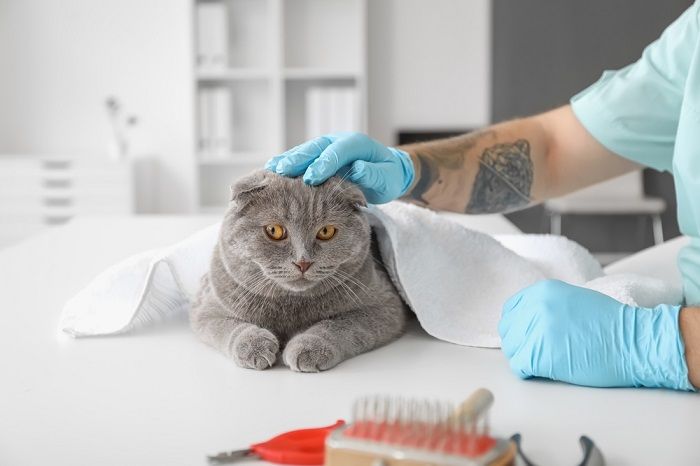
The technique you use will depend on where the poop is, whether it’s dried or wet, and how much of the cat’s body is affected.
There are a few different ways to get the poop out of the fur. Below are some suggestions.
Cat Bath
Some jobs are just too messy and require a full bath. Depending on the location of the poop, you might get away with just dipping your cat’s back end into the water, but if it has spread everywhere, they need a full-body bath.
Pop your cat in the tub, making sure they are fully covered with warm water, then start to massage shampoo into their fur, concentrating on the areas where the fecal matter is stuck. Rinse the shampoo thoroughly. You can use a cup to pour water on your cat, or the shower head if you are in a bathroom.
Ensure the soapy water doesn’t go in your cat’s eyes. Remember to use fresh water to rinse your cat and not water that has poop rinsed into it as you will just be adding more poop onto clean fur! Rinse your cat fully then remove them from the water and dry them. Make sure to dry around your cat’s butt, under their paws, and between their toes, too!
Also Read: How To Bathe A Cat (A Step By Step Guide)
Waterless Shampoo
Sounds crazy right, but this is a brilliant invention that allows you to clean small areas of your cat’s soiled coat without wetting their fur. Waterless shampoo usually comes in a spray bottle so you can just concentrate on the area that has the feces on. This is a fab option for cats that hate to be wet or refuse to be bathed.
It is also brilliant for poop that has gone hard and dried on your cat’s fur. Spray on the affected area then gently work off with a washcloth. Make sure you don’t use this cloth for anything else and clean it properly afterward. Alternatively, you can use a paper towel and throw it away.
Also Read: 8 Best Cat Shampoos & Conditioners
Pet Wipes
Pet wipes are basically like baby wipes for cats. They are super handy to have in the house to safely clean your cat. They can be used on wet poop but are less handy when the poop has dried up. They are most useful for feces that aren’t completely rubbed into the fur, for example, a bit of poop stuck to the area around your cat’s bottom.
Also Read: The 7 Best Cat Wipes For Dander And Dirt
Clippers/Scissors
If there are really tough hard clumps of poop that won’t budge with any of the above methods, you might have to resort to removing the hair with a quick snip from some scissors or using clippers. Be extremely careful when doing this so you don’t cut your cat’s delicate skin. If you have any doubts about your ability to do this safely, schedule an appointment with a pet groomer or your veterinarian instead.
Also Read: 8 Best Cat Nail Clippers
4. Aftercare for Your Cat
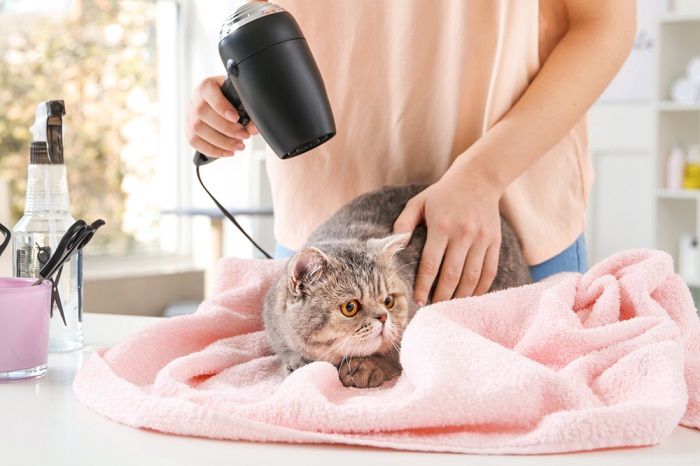
To avoid burning your cat’s skin, use a pet dryer or human dryer on the lowest setting.
Dry Your Cat
Once you have removed all the feces from your cat’s fur, depending on which method you used, it’s important to make sure your cat is completely dry. They will get very cold and uncomfortable if you leave them wet. Take care around your cat’s anus as they might be sensitive in this area but it does need to be dried.
Brush The Coat
When your cat is dry and clean, it’s a good idea to brush the coat through to ensure any tangles are removed and to prevent it from matting. This is especially important if your cat has long fur, but short hair cats need attention, too.
Also Read: 12 Best Cat Brushes & Deshedding Tools
Clean The Area
Once your cat is snuggly and warm and clean, you can concentrate on cleaning the area you used. Ensure that you properly disinfect everything that was in contact with your cat and the feces-contaminated water. Clean your cat’s litter box too as the smell of the poop might upset your cat, especially if the litter tray is placed close to your cat’s food.
Top Tips To Make It Easier for You and Your Cat
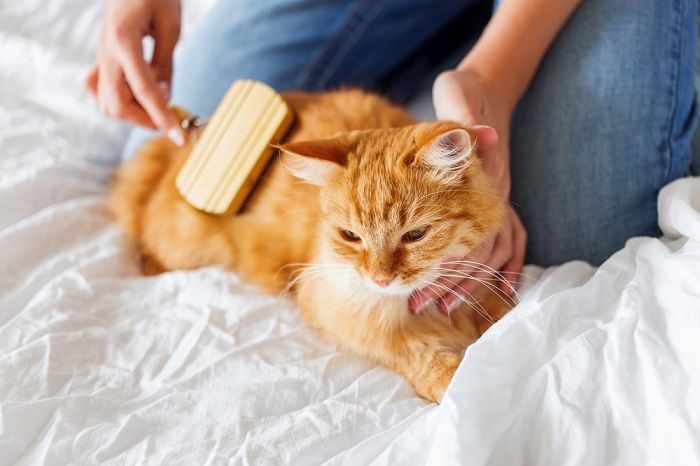
All cats should be trained to accept necessary grooming and cleaning up.
It’s very important to make sure your cat is used to being cleaned up, especially if you have a longhaired cat. Even if they are a super groomer themselves, at some point us pet owners are usually required to step in. If you use wipes or a spray, get your cat used to seeing the packet of wipes or the spray bottle without actually doing anything to them at first.
Then gradually do small bits on their fur when they are happy and relaxed so as not to stress them out. Offer your cat treats and soothing words of reassurance while you do this so that they learn that nothing bad is going to happen to them and that they are safe. To get your cat used to bath time regularly do small baths with them and make it fun.
Bring toys and offer them treats. Start by letting them place their paws in the water and play about and join in with their games yourself. If cats learn to associate the bath with happy, relaxed, one-on-one attention time with their favorite human, they are way more likely to get in the bath when they do need to be washed.
Another top tip is to check their paws after they have been in the litter box as they sometimes step in feces by accident and you can clean it off straight away before it dries. A pet wipe is great for small jobs like this.
Also Read: Why Do Cats Dig In Their Litter Box?
Final Thoughts
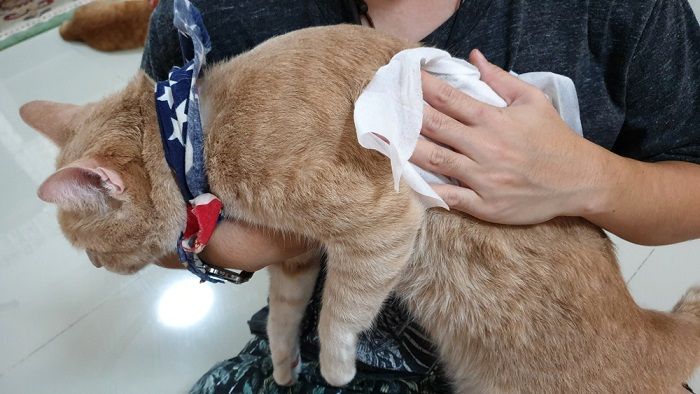
Pet wipes are excellent to keep on hand for minor clean-up jobs.
Cleaning poop out of your cat’s coat may not be the most exciting task, but sometimes it needs to be done. There are a few effective methods you can use depending on how much poop there is and if it is wet or not. Sometimes all it takes is a spray and a wipe; other times, a full-on bath is on the cards.
Also Read: Why Do Cats Lick And Clean Themselves?
Frequently Asked Questions
How do you get poop stuck out of fur?
There are a few ways to remove poop from cat fur, and it does depend on if the feces are dried or wet, and the location of the poop. The usual ways are
How do you get dried poop off a cat?
There are a few options to get dried, crusty poop out of fur. You can wet the fur and comb it out, you can bathe your cat, and you can use pet wipes. If the poop has made the fur very matted and tangled, sometimes the only option is to cut the feces out with scissors.
Do longhaired cats get poop stuck to fur?
Yes, they absolutely do. Long and shorthaired cats both get poop stuck to fur, unfortunately. It might be more challenging to remove from longhaired cats as there is more chance of the fur matting and getting in a knot. It's important to brush your cat's fur regularly and inspect the coat for bits of feces that may have gotten stuck and remove them quickly.
Do cats clean poop off themselves?
Cats do clean themselves, they are usually very good at self-grooming. They will clean poop off their coats. As long as it isn't dried and matted, or in a place that they can't reach, they will sort themselves out and save you a job!







